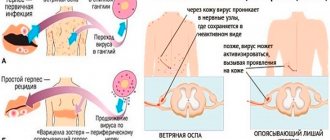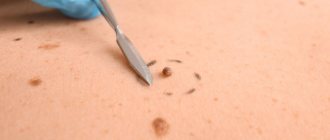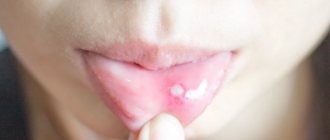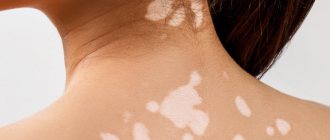White plaque on the gums can be a symptom of candidiasis, a disease caused by a fungus of the genus Candida. Under the influence of a fungal infection, stomatitis develops. First, multiple cheesy white rashes appear on the surface of the cheeks, tongue, palate and gums. Gradually they begin to grow. As the lesions grow, they merge and a film forms in the mouth.
At the beginning of the disease, plaque can be scraped off. But in the place where it was removed, small ulcers remain. When the disease is advanced, the whitish film can no longer be scraped off. The patient feels serious discomfort. Dryness, burning, pain, and a metallic taste appear in the mouth. In the advanced stage there are systemic symptoms. The head begins to hurt, the patient complains of lethargy and weakness, and the temperature rises.
Candida is an opportunistic microflora. They live in the oral cavity of any person. As long as their number is within normal limits, pathological conditions do not develop. If candida begins to multiply quickly, they provoke candidiasis.
Causes
- Weakened immunity. In people with weak immunity, the body's resistance decreases. Candida begins to multiply quickly.
- Hormonal imbalances. Changes in hormonal levels lead to various pathologies, and candidiasis is one of them.
- Pathologies of the gastrointestinal tract.
- Diabetes.
- Long-term use of antibiotics. These drugs disrupt the normal microflora. They kill not only pathogenic microorganisms, but also beneficial bacteria.
- Dental diseases. Candidiasis can be provoked by caries and inflammation in the oral cavity.
- Poor oral hygiene. Patients who do not pay proper attention to hygiene are more susceptible to white plaque.
- Dentures. An incorrectly selected denture puts pressure on the mucous membrane, causing it to rub. In these places, the color changes and the tissue structure is disrupted.
- Damage to the mucous membrane. It performs a protective function. Damage provokes various dental pathologies.
White plaque in the mouth is a sign of more than just candidiasis. It also accompanies other pathological conditions:
- Tooth cyst. This is a protective neoplasm that forms in response to the inflammatory process. When pathological cells die, a cavity with dense walls is formed around the necrosis zone, inside which there is liquid.
- Leukoplakia. This is a dense white growth on the gums and cheeks. Without treatment it leads to keratinization.
- Oncological diseases in the initial stage.
Sometimes a problem arises as a response to external irritation. For example, after brushing or whitening your teeth. In this case, it goes away on its own after some time.
Dentistry for those who love to smile
+7
Make an appointment
Ulcers caused by oral diseases
White sores in the mouth can appear due to diseases of the oral cavity. The most common cause is stomatitis. It comes in several types:
- aphthous;
- herpetic;
- bacterial;
- fungal.
| White ulcers in adults and children occur with aphthous and herpetic stomatitis. This disease can appear due to stress, untreated caries, lack of vitamin C, or overexertion. It is better not to self-medicate, but to immediately consult a doctor. Recommendations, in addition to medications, may include treatment of caries, a balanced diet, stress reduction, etc. |
| There are two separate forms of stomatitis - Bednar's aphthae and Setton's aphthae. The former develop only in a child due to injury to the mucous membrane or poor oral hygiene. Such rashes are also called erosions. Setton's aphthae is a more complex and painful phenomenon. It begins with the appearance of compactions, which then develop into painful ulcers. They most often form on the inside of the cheeks, in the corners of the lips and on the sides of the tongue. |
| Another cause of white sores is gingivitis. In smokers, such rashes are much more common due to the effects of nicotine on the mucous membranes. Those who have poor oral hygiene, reduced immunity and hormonal imbalances are also at risk of encountering gingivitis. If left untreated, it can progress to periodontitis: when the tissue that supports the tooth is affected. And this is a direct path to tooth loss. |
Treatment
The treatment program is selected depending on what causes the white plaque on the gums:
- Antifungal drugs. Prescribed if the disease is caused by candida.
- Treatment of the oral cavity with antiseptics. To do this, you can use hydrogen peroxide, chlorhexidine, miramistin, and potassium permanganate solution. Apply the product to a sponge and gently apply it to the affected areas.
- Special toothpastes. The doctor will recommend the use of special pastes that contain the enzymes lactoferrin, lactoperoxidase, and lysozyme. They are necessary in order to restore the microflora.
- Therapy aimed at restoring the immune system. The specialist will recommend medications, vitamins, and a special diet.
Ulcers caused by trauma
The main reason for the appearance of ulcers when the mucous membrane is injured is infection in the wound. Most often, white rashes occur due to the habit of biting nails or the tip of a pencil or pen.
Fans of seeds and hard toothbrushes may also be at risk. Many people believe that hard bristles remove plaque better. Actually this is not true. If you carefully brush your teeth with such a brush, you can damage the enamel, gums and cause inflammation.
Other causes of mucosal injury:
- uncomfortable dentures;
- braces or other orthodontic structures;
- habit of unconsciously biting your cheek or tongue;
- exposure to mucous membranes with drugs or acids.
How to treat?
It is enough to remove the irritating factor and wait 1 - 2 weeks. Usually the ulcers go away on their own. If this does not happen, it is recommended to consult a doctor.
White plaque and plugs on the tonsils
04.09.2021
The tonsils are the tonsils on the roof of your mouth that are located close to the larynx. They consist of lymphoid tissue. They belong to paired human organs. The tonsils perform functions such as protective and hematopoietic. In addition, they take part in the development of the immune system . The surface of the tonsils has a cavernous character. These depressions are called crypts or lacunae. Inflammation of the organ causes it to become covered with pus, which clogs the crypts. Because of this, traffic jams form. Next, we will consider information about what diseases are symptoms of inflammation of the tonsils , and what needs to be done.
Causes of white plaque and plugs on the tonsils
In most cases, inflammation of the tonsils indicates a disease called tonsillitis . It can be either acute or chronic.
In addition, the appearance of purulent plaque may be caused by the following reasons:
- frequent ARVI
- runny nose that lasts a long time
- dental disease ( caries )
- diphtheria
- scarlet fever
- infectious mononucleosis, etc.
Food can also cause clogging of lacunae. Products such as cheese, cottage cheese, nuts, seeds can cause specified consequences.
Treatment of inflammation of the tonsils
Inflammation the tonsils is accompanied by bad breath , a feeling of constant sore throat , pain during swallowing and changes in the voice. But these are not all the consequences. Much more serious is the appearance of problems with important vital organs, namely the heart , kidneys and liver .
Such appearances occur due to the fact that toxins enter the circulatory system, which are a consequence of the emergence of pathogenic bacteria in the clogged cavernous bodies of the tonsils . Therefore, treatment of the tonsils should not be delayed. To do this, first of all, you need to consult a doctor for a correct diagnosis and explanation of the treatment method. Very often, the only correct treatment for frequent inflammation of the tonsils is considered to be their surgical removal . However, more and more often there is an assertion that this is not the only way out of the situation; the conservative method also allows one to achieve positive results.
Contrary to the opinion of doctors who insist on removal , other doctors and researchers consider the tonsils to be a very important organ. It not only performs the function of protecting the immune system , but even resists the appearance of malignant tumor cells. Chronic inflammation of the tonsils is treatable, but it takes a long time. To achieve this, there is a set of measures that need to be repeated periodically. These are measures such as:
- physiotherapeutic procedures, for example, UHF, ultrasound and others
- mouth rinses
- lubricating the tonsils with antibacterial agents and injecting with anti-inflammatory drugs
- using medications to strengthen the immune system
Removing purulent plugs from the tonsils
Sometimes it happens that cleansing occurs naturally. At the same time, dense lumps enter the oral , improving the patient’s condition. But if the inflammation is caused by tonsillitis , then pus is constantly released, without giving time for cleansing. The hospital may remove the pus plugs. To do this, they are washed with a special solution. In this case, vacuum suction can also be used under local anesthesia.
Under no circumstances should you attempt to remove traffic jams yourself. Pressing with fingers or other objects can only aggravate the condition; pus can penetrate even deeper into the crypts.
Prevention of congestion in the tonsils
To prevent the occurrence of purulent plugs on the tonsils , after meals you need to gargle with a solution of soda (a teaspoon in a glass of warm water). to treat sore throat :
- furatsilin or streptocid (in the ratio of 20 g of the drug per 100 ml of hot water)
- chlorophyllipt solution in alcohol
- chamomile infusion (1 tsp flowers per glass of boiling water, wait 20 minutes for it to settle)
Published in Otorhinolaryngology Premium Clinic
Symptoms and treatment of leukoplakia -
Leukoplakia is characterized by the fact that under the influence of various irritants, keratinization of the epithelium of the oral mucosa begins to occur. This process occurs due to a violation of the desquamation of the epithelium in those areas of the mucous membrane that is exposed to pathological irritants. These irritants can be:
- smoking,
- sharp edges of carious teeth,
- overhanging edges of fillings,
- malocclusion,
- excessive consumption of spices, very hot foods,
- poorly manufactured removable dentures,
- the presence of artificial crowns made of different metals on the teeth, which gives rise to galvanic currents in the oral cavity.
White spots on the gums with leukoplakia: photo
Symptoms of leukoplakia:
The main element of leukoplakia is a white plaque, which may rise above the level of the mucous membrane, but may not rise (as in Fig. 4). In addition, the plaque can have both clear and blurred boundaries. Patients most often call such plaques white spots. As a rule, white spots do not bother their owners and are discovered completely by accident.
In some cases, patients may be concerned about the roughness of the mucous membrane at the site of the white spot, as well as the fact that the mucosa in this place may rise above the level of the mucosa. In some cases, cracks and ulcers may appear on the surface of the stain; in this case, the patient may also be bothered by burning and pain. If leukoplakia develops as a result of smoking, then, as a rule, patients first of all complain of dryness and burning of the oral mucosa (24stoma.ru).
Treatment of leukoplakia will primarily involve eliminating exposure to the irritating factor. Those. it will be necessary to eliminate the impact of the overhanging edge of a filling or crown, replace old low-quality dentures, normalize oral hygiene, and of course, solve something with the effects of nicotine and hot dry air on the mucous membrane (which occurs when smoking).
Only after this are prescribed keratolytic agents for topical use (3-5-10% salicylic acid, celandine infusion), and vitamin therapy. Applying any treatment procedures without eliminating the causative factor will be useless.
The danger of leukoplakia –
Leukoplakia belongs to the category of precancers. Malignancy of leukoplakia, i.e. its transition to cancer occurs in 15-75% of cases (depending on its form). Therefore, if you do not want to develop cancer of the oral mucosa, you need to urgently go to the dentist and look for the cause of its appearance. But in the photo below you can see photos of two clinical cases when leukoplakia transformed into a malignant tumor of the oral mucosa and the red border of the lips.
Cases of cancer associated with leukoplakia –
Special recommendations for the treatment of white ulcers on the oral mucosa
To quickly get rid of unpleasant ulcerations in the mouth, you need to follow a diet. Your diet should include vegetables, fruits, red meat, and fish. It is important to avoid spicy and sour foods, such as citrus fruits, until complete recovery. Any rough food (nuts, etc.) that can injure the mucous membrane is also excluded. Sweets (cakes, jam, chocolate), crackers, chips, coffee are also prohibited.
It is important to pay attention to the quality of the water consumed. The heavy metal salts and other impurities it contains can cause constant bleeding from the gums and contribute to infection. If the pathology is provoked by some disease, it is necessary to eliminate it.
White ulcer on the oral mucosa: how to deal with the problem
White sores in the mouth appear quite often. Although the problem cannot be called critical, it causes significant discomfort. Difficulty talking, chewing, swallowing and smiling. In some cases there is pain. Therefore, everyone who has ulcerative formations wants to get rid of them as quickly as possible. In this case, you cannot self-medicate. To determine the cause of the ulcers and prescribe effective therapy, it is necessary to undergo examination by a specialist.
Question No. 6. Which doctor should I see?
The first visit is best to the dentist, since often it is dental pathologies that provoke the appearance of the problem. Subsequently, the patient can be referred to specialized specialists for examination, clarification of the diagnosis and prescription of specific treatment: infectious diseases specialist, dermatologist, allergist, venereologist, gastroenterologist, endocrinologist, oncologist.
The first thing you should do is contact your dentist









